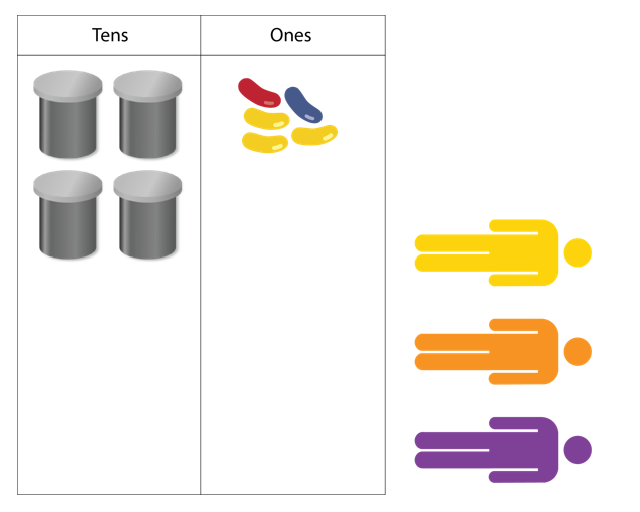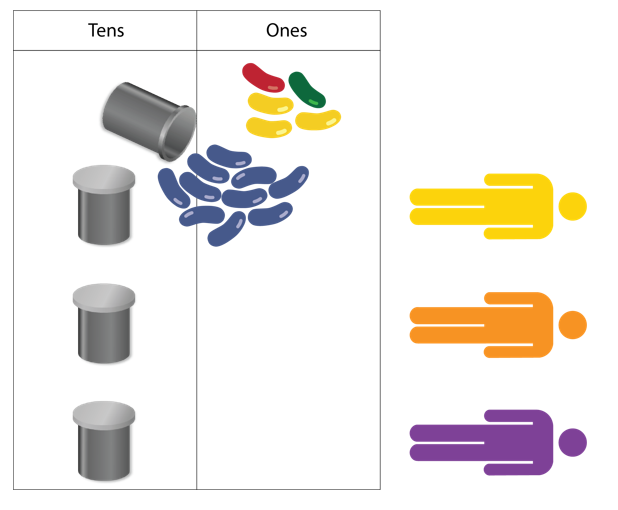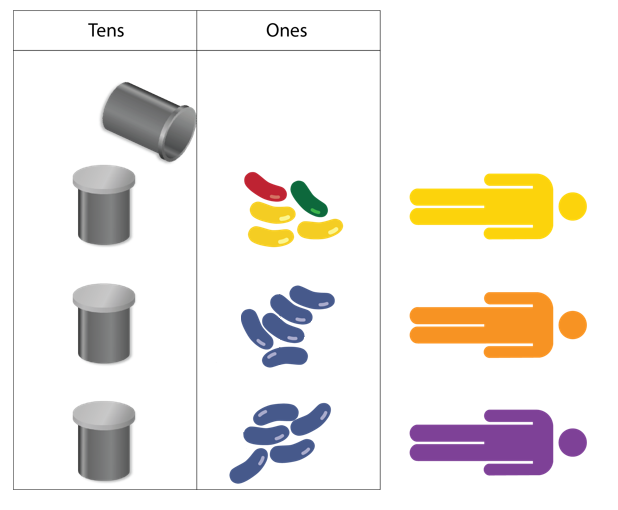The purpose of this activity is to support students applying their knowledge of division to solve equal sharing problems. Place value is recognised as a useful structure for partitioning the number being divided (the dividend). This is the basis of written algorithms (step by step procedures) and allows for the number being divided to be extended beyond the range of known basic facts.
- Individual objects of interest and relevance to students. This lesson uses BeaNZ in canisters
 Pose an equal sharing problem that requires students to think beyond basic multiplication facts.
Pose an equal sharing problem that requires students to think beyond basic multiplication facts.
I have 45 beans to share between three people. How many beans will each person get?
Set up an equipment model (e.g. using BeaNZ, canisters to represent groups of 10 beans, and a two-column place value table) of the problem and ask students to anticipate the equal share for each person.
- Students are likely to distribute the highest place values first, meaning they will give ten beans (a canister) to each person. The remaining canister cannot be shared equally unless it is ‘decomposed’ into ones.


The operation can be recorded using working forms, or written equations. Below are two useful algorithms, the short form, and the ladder method. The ladder method is useful when division becomes more complex and allows students to make progressive approximations until the full answer (quotient) is found.
- Discuss the connection between the symbols and manipulation of materials, drawing particular attention to how the decomposition of 10 is recorded.
The ‘one’ recorded beside 5, is one set of ten, expressed as ten ones.
- Provide further, similar problems. Allow students to work in groupings that will encourage peer scaffolding and extension. Some students might benefit from working independently, whilst others might need further support from the teacher.
Look for students to generalise a procedure that involves using place value to partition to dividend. Restrict the dividend to two digits until students gain procedural fluency. Use equipment to model the quantities with the aim of relying on symbols when the place value structures are secure.
Suitable problems include:- I have 75 beans to share between five people. How many beans will each person get?
- I have 72 beans to share between six people. How many beans will each person get?
- I have 96 beans to share between four people. How many beans will each person get?
- I have 81 beans to share between three people. How many beans will each person get?
- Depending on students’ progress, you might extend the dividend to three digits. The equipment model, and algorithm, are more complex with multiple steps. Below is a ladder algorithm used to solve the problem, “I have 628 beans to share between four people. How many beans will each person get?”

Next steps
- Increase the level of abstraction by gradually withdrawing scaffolding, such as progressing from using materials to algorithms. Increase the difficulty of problems in two ways:
- Progress from two-digit dividends to three-digit dividends.
- Progress from using 2, 3, 4 and 5 as the divisors to using 6, 7, 8, and 9.
- Ask anticipatory questions that promote estimation. Ask questions like:
What size will the quotient (answer) be? Will it be more or less than ….? How do you know?
- Continue to promote the connection between division and finding a unit fraction of a number, and record aligned equations, such as 64 ÷ 4 = 16, 1/4 x 64 = 16.
- With students, develop division word problems that call on relevant contexts.